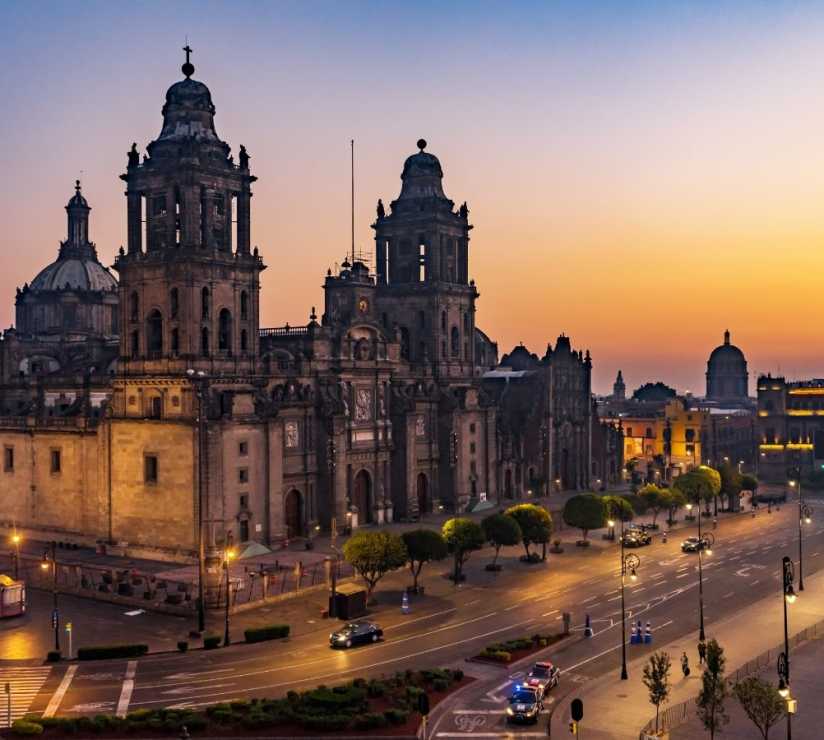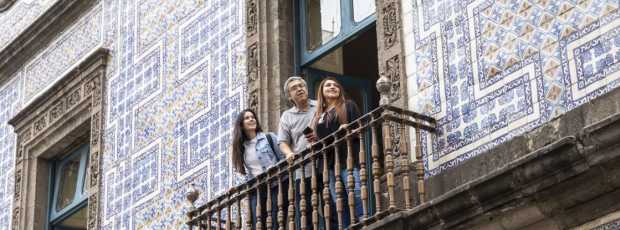Table Of Contents
- The Month That Teaches You to Travel Differently
- Understanding October's Rhythm
- Where October Shows Its True Character
- The Neighborhoods That Matter in October
- Cultural Depth: Beyond the Tourist Version
- Practical October Strategies
- The Walking Tours You Won't Find in Guidebooks
- Experiences That Define October in Mexico City
- What October Taught Me About Travel
- Planning Your October Visit
- Beyond the Guidebook Version
The Month That Teaches You to Travel Differently
October in Mexico City taught me that the best trips happen when you stop trying to see everything. The weather hovers between warm afternoons and cool evenings, perfect for the kind of walking that lets a city reveal itself gradually. Most visitors rush through the Centro Histórico in a morning, but October invites you to spend entire afternoons watching how light moves across colonial facades. This is one of the greatest times to visit Mexico City.
The tourist areas thin out compared to peak season, which means you can actually hear yourself think in places like the main square. I've learned more about visiting Mexico by sitting in Plaza de la Constitución on a Tuesday afternoon in October than from any guided tour.
Understanding October's Rhythm
This month belongs to transitions. School is back in session, which changes the city's daily rhythm. Markets shift their focus toward ingredients for Día de Muertos preparations. The entire country begins a subtle transformation that visitors often miss if they're only looking at the obvious attractions.
Recent years have brought more international visitors to Mexico City in October, drawn by Day of the Dead celebrations. But most arrive in the final week, missing the month's deeper rhythm. The real magic happens in the quiet preparation, not just the final celebration.
Looking for a private city experience in Mexico City?
Explore the city with a local who plans a private day just for you; no groups, no scripts.
Where October Shows Its True Character
The Centro Histórico Reveals Itself
Mexico City's Centro Histórico transforms in October. Without summer's oppressive heat or winter's occasional rain, you can actually appreciate the UNESCO World Heritage Site's architectural details. I spend hours walking these streets, noticing how afternoon light hits the facades of buildings that have stood since the 16th century.
The Palacio de Bellas Artes becomes essential viewing in October, not just for its architecture but for the special exhibitions that coincide with cultural celebrations. Diego Rivera's famous mural takes on different meaning when you understand it as part of Mexico's broader conversation with its past.
Templo Mayor: An Ancient City Beneath Your Feet
The archaeological site of Templo Mayor feels particularly powerful in October. This ancient city, once the heart of the Aztec era, connects directly to modern Día de Muertos traditions. The museum underground provides context that most visitors skip, but October's contemplative mood makes it worth the extra time.
Standing in the ruins while modern Mexico City pulses around you creates a layered experience that defines what makes this trip different from anywhere else in the world.
The Neighborhoods That Matter in October
Roma Norte: Where Locals Actually Live
La Roma, specifically Roma Norte, shows you how locals navigate their daily life. October brings perfect weather for wandering streets lined with art galleries, independent bookstores, and cafes where people actually work on laptops. This isn't performance, it's real life happening at a pace that lets you participate rather than just observe.
The food vendors here serve better tacos than most restaurants tourists find. Things to do in Mexico City in October - eat street food! October means you can eat outdoors comfortably, watching neighborhood rhythms unfold around you.
La Condesa: Parks and Daily Rhythms
La Condesa's tree-lined streets and central park system work perfectly in October's mild weather. Locals use Parque México for everything from morning exercise to evening conversations. Sitting here on an October afternoon, you understand why people choose this neighborhood over flashier tourist areas.
The boutique hotels in La Condesa fill up during peak season, but October offers better rates and a chance to experience the area without feeling like you're in a travel magazine photo shoot.
Cultural Depth: Beyond the Tourist Version
Día de Muertos: The Real Story
The Day of the Dead isn't Halloween with skulls. Día de Muertos, celebrated November 1st and 2nd, represents a fundamental difference in how Mexican culture approaches death and memory. October is when families begin preparing; buying marigolds, making plans, creating ofrendas.
Visiting Mexico City in October means witnessing the preparation for Day of the Dead, rather than just the final celebration. Markets throughout the city begin stocking pan de muerto, families visit cemeteries to clean gravesites, and the entire atmosphere shifts toward remembrance and connection.
The tourist version focuses on colorful decorations and photo opportunities. The authentic experience involves understanding that this is a time when families commune with deceased relatives in ways that make death feel less final and more connected to ongoing life.
Museums That Make Sense in October
The National Museum of Anthropology deserves a full day in October's comfortable weather. Rather than rushing through to check boxes, you can spend time understanding how pre-Hispanic cultures viewed death and celebration; context that makes Día de Muertos traditions more resonant.
Most museum visits in Mexico City feel like homework. In October, with the cultural context of approaching celebrations, they become conversations with living traditions rather than displays of dead artifacts.
What if your day in Mexico City was planned by someone who knows it — and you?
City Unscripted matches you with a local host who creates a private experience based on your interests, not a set route.
Practical October Strategies
Getting Around the City
Public transportation works efficiently in October's mild weather. The Metro system connects all major areas, but October is perfect for walking between nearby destinations. Paseo de la Reforma becomes a pleasure rather than an endurance test when temperatures cooperate.
From Aeropuerto Internacional Benito Juárez, the city feels manageable in October. The heat doesn't exhaust you immediately, and the tourist crowds haven't reached peak density.
Where to Sleep and Eat
Skip the obvious hotel recommendations. October's weather makes rooftop spaces and courtyards comfortable, so look for accommodations that offer outdoor areas. Many boutique hotels in Roma Norte and La Condesa provide better value in October than during peak season.
For restaurants, October means you can enjoy street food without worrying about heat affecting freshness. Food vendors operate more comfortably, and outdoor seating becomes pleasant rather than something to endure.
The Walking Tours You Won't Find in Guidebooks
Following Diego Rivera's Path
Rather than visiting isolated murals, October weather allows for walking tours that connect Diego Rivera's major works throughout the city. Start at the Palacio Nacional, walk to Bellas Artes, then continue to locations where his vision of Mexican history unfolds across multiple sites.
This becomes a walking tour of Mexican revolution history and post-revolutionary culture rather than just art appreciation.
Archaeological Sites Within the City
Beyond Templo Mayor, Mexico City contains multiple archeological sites that most visitors never see. October's comfortable walking weather makes it possible to visit Tlatelolco, Cuicuilco, and smaller sites that provide context for understanding how ancient civilizations shaped the modern city.
These aren't tourist attractions, they're windows into layers of history that exist beneath daily Mexican life.
Experiences That Define October in Mexico City
Markets Beyond the Tourist Circuit
Mercado de Medellín and Mercado Roma offer different perspectives on local food culture. October means seasonal ingredients appear that you won't find other times of year. Vendors prepare for Día de Muertos by stocking special items, giving markets a different energy than typical tourist shopping.
These locations show you how locals actually shop and eat, rather than performing for visitors.
Live Music and Cultural Events
October brings cultural events that locals attend rather than shows designed for tourists. Small venues throughout Roma Norte and Centro host musicians and poets who draw neighborhood audiences. The authenticity comes from being in spaces where you're participating in local culture rather than consuming a version created for outsiders.
Lucha libre wrestling matches happen year-round in Mexico City, but October crowds include more locals celebrating before Día de Muertos season begins.
Tip
We match you with the right host, not just any guide.Want to experience the real Mexico City with someone who lives there?
A fully private experience, planned and led by a local host who tailors the day to you
What October Taught Me About Travel
Slowing Down Changes Everything
Most visitors try to see Mexico City in three days. October taught me that spending a week walking slowly reveals more than rushing through checklists. The city's layers; pre-Hispanic, colonial, revolutionary, modern, become visible when you move at a pace that allows for discovery rather than completion.
Context Matters More Than Coverage
Understanding why Día de Muertos matters to Mexican culture provides more insight than visiting ten museums without context. October offers natural entry points into cultural understanding that make subsequent visits to tourist areas more meaningful.
Local Rhythm vs. Tourist Schedule
Mexicans in October are preparing spiritually and practically for important celebrations. Aligning your travel rhythm with local priorities creates different experiences than following tourist itineraries that ignore cultural context.
Planning Your October Visit
Weather and What to Pack
October temperatures range from 60-75°F, perfect for walking and outdoor dining. Pack layers for temperature changes between morning and evening. Rain is minimal, making it ideal for exploring archeological sites and outdoor markets.
Timing Within the Month
Early October offers the most authentic experience of local preparation for Día de Muertos. Late October brings more tourists but also more organized cultural events. Mid-October provides the best balance of cultural activity and manageable crowds.
Tickets and Reservations
Book museum tickets in advance, especially for the National Museum and Templo Mayor. October weekends see increased local visitors preparing for upcoming celebrations. Many cultural events in October don't require advance booking but benefit from local knowledge about timing and locations.
Beyond the Guidebook Version
October in Mexico City taught me that the best travel experiences happen in the spaces between planned activities. The conversations with vendors preparing for Día de Muertos, the afternoons spent reading in Chapultepec Park, the evening walks through Centro Histórico when tourist groups have returned to their hotels, these moments define what makes visiting Mexico different from checking items off travel lists.
The city in October operates at a pace that allows for genuine discovery rather than hurried consumption. Weather cooperates, locals engage more readily, and cultural contexts become accessible in ways that create lasting understanding rather than temporary entertainment.
This is why October changed how I travel everywhere: it taught me that places reveal themselves when you move slowly enough to notice what locals consider important. Mexico City in October isn't just a destination, it's a masterclass in how to be present in unfamiliar places while respecting the rhythms that make them home to millions of people.
For those considering things to do in Mexico City in November, the foundation you build through October's contemplative pace makes November's full Día de Muertos celebration infinitely more meaningful. The preparation becomes as valuable as the celebration itself.
Pro tip: The best Mexico City experiences in October happen when you least expect them. Stay curious, walk slowly, and let the city's October rhythm teach you something about being present in places that existed long before you arrived and will continue long after you leave.
Ready to plan your perfect day in Mexico City?
Start your experienceWhat if your day in Mexico City was planned by someone who knows it — and you?
City Unscripted matches you with a local host who creates a private experience based on your interests, not a set route.
Want to experience the real Mexico City with someone who lives there?
A fully private experience, planned and led by a local host who tailors the day to you











